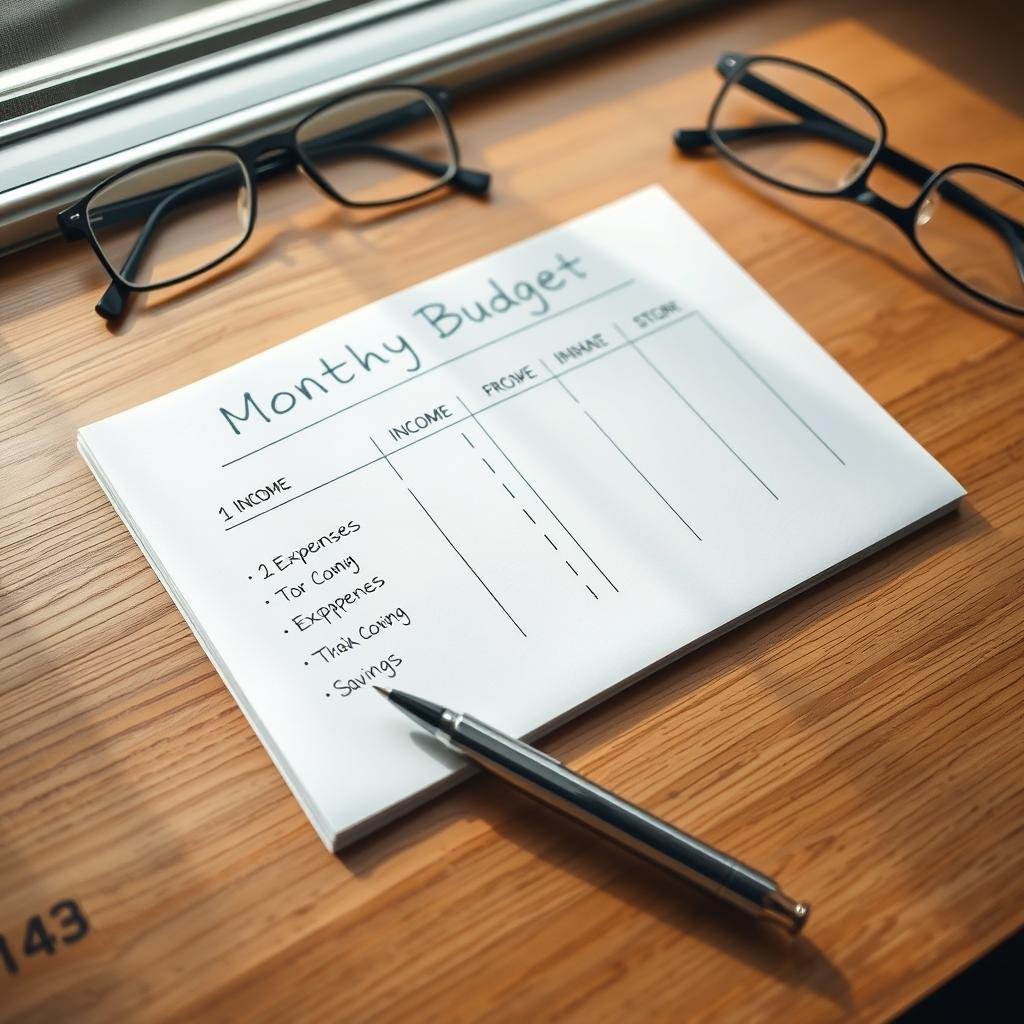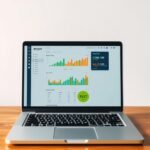
Simple Budgeting Tips For Beginners
Posted in :
Managing your money well is key to less stress and more security. Many people find it hard to stop overspending and save. They get lost in all the different budgeting ways.
Starting with budgeting tips for beginners is a great first step. Learning the basics of budgeting101 helps you make smart money choices. It’s the start of building a solid financial base.
With some help, anyone can get good at budgeting. And that brings a lot of peace of mind.
Understanding the Basics of Personal Finance
Knowing about personal finance is key to financial stability and security. It’s about making smart money choices to reach your goals. At its heart, personal finance is about managing your income, expenses, savings, and investments well.
What Is a Budget and Why You Need One
A budget is a simple plan that shows your expected income and expenses over time. It helps you see where your money goes and find ways to save on things you don’t need. Experts say a budget is vital because it helps you manage your money better, save for later, and reach your financial dreams.
To make a budget, first, figure out how much you make. Then, list all your expenses. Lastly, set financial goals. This way, you use your money wisely and get closer to financial stability.
Common Financial Terms Every Beginner Should Know
To get good at personal finance, knowing key terms is important. Terms like assets, liabilities, equity, and compound interest are basic. Assets are things you own that are worth something, liabilities are debts, and equity is what you own minus what you owe. Compound interest is interest on both the original amount and any interest already earned.
- Assets: What you own that has value.
- Liabilities: Your debts or financial obligations.
- Equity: The value of your assets minus your liabilities.
- Compound Interest: Interest on both the principal amount and any accrued interest.
Knowing these terms helps you make better financial choices and plans.
Budgeting Tips for Beginners: Getting Started
Starting your budgeting journey means understanding your finances. As a beginner, it’s key to look at your current financial state. This helps you make smart choices about your money.
Assessing Your Current Financial Situation
To make a good budget, you need to know your income and expenses. Start by collecting all your financial papers, like bank statements and bills. This will show you where your money comes from and where it goes.
Tracking your expenses is very important. For a month, write down every transaction, big or small. This will show you where you can save money. As David Bach, a well-known financial author, once said,
“The key to financial freedom is not about making more money, but about making the money you have work for you.”
Setting Realistic Financial Goals
After understanding your finances, set realistic goals. These could be short-term, like saving for a trip, or long-term, like buying a house. Your goals should be clear, measurable, and achievable.
- Identify what you want to achieve.
- Set a specific timeline for achieving your goals.
- Determine the steps needed to reach your goals.
Creating Your First Budget Template
With your goals in mind, create a budget template. Start with the 50/30/20 rule. This means 50% for necessities, 30% for fun, and 20% for saving and debt.
| Category | Percentage | Amount |
|---|---|---|
| Necessities | 50% | $2,500 |
| Discretionary Spending | 30% | $1,500 |
| Savings & Debt Repayment | 20% | $1,000 |
By following these steps, you’ll make a budget that suits you. Remember, budgeting is an ongoing process that needs regular checks and changes.
The 50/30/20 Rule: A Simple Budgeting Framework
Effective budgeting is key to financial stability. The 50/30/20 rule is a simple yet powerful way to manage your money. It suggests using 50% for necessary expenses, 30% for discretionary spending, and 20% for saving and debt repayment.

This rule helps create a balanced budget. It meets your financial needs and helps you reach your long-term goals. Let’s explore how to use this rule effectively.
Allocating 50% to Needs
The first step is to use 50% of your income for necessary expenses, or “needs.” These include:
- Rent or mortgage payments
- Utilities such as electricity, water, and gas
- Groceries
- Transportation costs, including fuel, maintenance, and insurance
- Minimum payments on debts
These expenses are essential for a basic standard of living. By using 50% for these needs, you avoid debt.
Designating 30% to Wants
The next 30% is for discretionary spending, or “wants.” This includes:
- Dining out or ordering takeout
- Entertainment, such as movies, concerts, or hobbies
- Travel
- Personal pampering, like spa treatments or salon services
- Upgrades or luxury items
These expenses are not essential but improve your quality of life. It’s important to balance enjoying life now and saving for the future.
Committing 20% to Savings and Debt Repayment
Lastly, 20% should go to saving and debt repayment. This includes:
- Building an emergency fund
- Retirement savings
- Paying off high-interest debts
- Other long-term savings goals, such as a down payment on a house
By focusing on savings and debt repayment, you build a strong financial foundation. This is key for securing your financial future and reducing stress.
The 50/30/20 rule simplifies budgeting and helps you reach your financial goals. It offers a clear guideline for managing your finances effectively.
Tracking Your Expenses: Methods That Actually Work
Knowing where your money goes is key. The right way to track expenses can really help. It lets you see where you can save and spend better, leading to smarter money management strategies.
Digital Tools and Apps for Expense Tracking
Today, many apps and tools make tracking expenses easy. Apps like Mint, Personal Capital, and YNAB (You Need a Budget) are popular. They help by categorizing expenses, tracking bills, and setting financial goals.
Mint, for example, lets you connect your bank and credit cards. It gives a full view of your money. The Verge says Mint is a top free budgeting tool, easy to use and full of features.
The Envelope System for Cash Spending
If you like old-school methods or use a lot of cash, try the envelope system. It’s simple. You split your money into categories (like groceries or fun) and put it in labeled envelopes.
“The envelope system is a straightforward way to stick to your budget, as it makes you physically allocate cash for different expenses,” notes financial expert Dave Ramsey.
How to Categorize Your Expenses Effectively
It’s important to group your expenses to understand your spending. Common groups are housing, transportation, food, insurance, and fun. Make sure your categories fit your life and money goals.
| Category | Monthly Budget | Actual Spending |
|---|---|---|
| Housing | $1,500 | $1,550 |
| Transportation | $300 | $320 |
| Food | $500 | $480 |
Tracking and grouping your expenses helps you improve your budgeting techniques. It helps you make smart choices with your money.
Budgeting Techniques for Different Income Types
Different income types need different budgeting strategies. Whether you have a steady job, freelance, or live paycheck-to-paycheck, adjusting your budget is key to financial stability.

Budgeting with a Regular Paycheck
Having a regular paycheck makes budgeting easier. You know how much money you’ll get each month. It’s important to split your income into needs, wants, and savings.
The 50/30/20 rule is a good starting point. It suggests using 50% for needs, 30% for wants, and 20% for savings and debt.
To manage your regular income well, set up automatic savings and bill payments. This helps keep your spending in check and saves time.
Managing Irregular or Freelance Income
Freelancers and those with variable income face special challenges. Income can vary greatly from month to month. A smart move is to average your income over several months to stabilize your budget.
Keep a financial cushion for lean months. Save some of your income during good months to help during tough ones.
Budgeting When Living Paycheck-to-Paycheck
Living paycheck-to-paycheck can be tough, but there are ways to manage. First, pay for essential expenses like rent, utilities, and groceries. Then, use any leftover money for other costs, savings, or debt.
If you’re barely making ends meet, look for ways to cut costs or earn more. Reduce non-essential spending, find extra work, or talk to service providers about lower bills.
Smart Saving Strategies for Financial Newbies
For those new to managing their finances, smart saving strategies are key. Saving money is vital for financial health and security.
To save effectively, understanding the importance of a solid financial foundation is essential. Several strategies can help beginners build a stable financial future.
Building Your Emergency Fund First
Start by building an emergency fund. This fund covers unexpected expenses like car repairs or medical bills. Aim to save 3-6 months’ worth of living expenses in a savings account.
Why is an emergency fund important? It prevents debt and gives peace of mind with a financial cushion.
Automating Your Savings
Automating your savings is another smart move. Set up automatic transfers to your savings or investments. This way, you save regularly without thinking about it.
Benefits of automating savings include:
- Consistency in saving
- Reduced likelihood of spending on non-essential items
- Building savings over time with little effort
Finding “Hidden Money” in Your Current Budget
Reviewing your budget can reveal “hidden money” for savings. Look for areas to cut back on unnecessary expenses.
| Category | Current Spend | Potential Savings |
|---|---|---|
| Dining Out | $500/month | $200/month |
| Subscription Services | $150/month | $50/month |
| Entertainment | $300/month | $100/month |
By using these smart saving strategies, financial newbies can secure their future. Saving is a habit that takes time and discipline. But with persistence and the right strategies, it becomes natural.

Tackling Debt While Budgeting
Managing debt is a key part of budgeting. It might seem hard at first, but it’s doable with the right steps.
To tackle debt, understand your current finances. Make a list of all your debts, like credit cards and loans. Prioritizing your debts is key to focus on the most urgent ones first.
Prioritizing Which Debts to Pay Off First
When sorting debts, look at interest rates, urgency, and total amount. It’s wise to tackle debts with high-interest rates first, as they cost more over time.
- List all your debts from the smallest balance to the largest.
- Identify the interest rates associated with each debt.
- Consider any urgent debts that could have severe consequences if not paid, such as mortgage or utility bills.
The Snowball vs. Avalanche Method
There are two main ways to pay off debt: the snowball and avalanche methods. The snowball method starts with the smallest debt to build momentum. The avalanche method targets high-interest debts first to save on interest.
“The debt snowball method is a great way to build momentum and see quick results, which can be very motivating,” says financial expert Dave Ramsey.
Which method you choose depends on your goals and situation. Some like the snowball for its motivational effect. Others prefer the avalanche to save on interest.
Avoiding New Debt While Budgeting
While paying off old debt, avoid new debt. Cut unnecessary expenses, avoid new credit checks, and use credit cards wisely.

By focusing on debt repayment and disciplined spending, you can improve your finances. Using effective money management strategies will help you reach your financial goals.
Practical Money Management Strategies for Daily Life
Managing money every day can be easier with the right strategies. Simple techniques can help you cut down on spending. This way, you can save more for your goals.
Grocery Shopping on a Budget
Grocery bills can be a big expense. Plan your meals and make a list to avoid buying things you don’t need. Buying in bulk and choosing generic brands can save a lot of money.
Warren Buffett said, “Do what you would do if you were going to be there forever.” This advice is great for grocery shopping. Spending time on planning can save you money in the long run.

Reducing Utility and Subscription Costs
Utility bills and subscriptions can add up fast. Be smart about how you use things. Turning off lights and adjusting your thermostat can help.
- Check your subscriptions often to see if you’re using them.
- Look into bundling services or negotiating with providers for better deals.
- Use energy-efficient appliances and practices to save on bills.
Socializing Without Breaking Your Budget
Socializing is key, but it doesn’t have to cost a lot. Try hosting events at home or find free activities like hiking or game nights.
“The key is not to prioritize what’s on your schedule, but to schedule your priorities.” – Stephen Covey
By focusing on your financial goals and planning your social life, you can enjoy social activities without overspending.
Adjusting Your Budget: Making It a Living Document
A budget is living when it changes with your finances. It helps you reach your money goals. For financial planning for newbies, it’s key to keep up with money changes.
Checking and tweaking your budget often keeps you on the right path. It’s about being ready for changes, like income shifts or new expenses. This way, you make smart money choices.
Monthly Budget Reviews: What to Look For
Doing a monthly budget check is vital. It makes sure your budget fits your current money situation. Look at your income, bills, savings, and debt payments. See where you can do better and tweak your budget.
Some important things to check in your monthly reviews are:
- How you spend your money
- How close you are to saving goals
- Any changes in income or bills
- Any surprise costs

Handling Unexpected Expenses and Windfalls
Life brings unexpected costs and extra money. For unexpected bills, like car fixes or medical costs, update your budget. You might cut back in other areas or use your emergency fund.
But, if you get extra cash, like a tax refund or bonus, use it wisely. Put it towards savings, debt, or investments. This helps you grow your financial future.
Being ready to adjust your budget for surprises and extra money keeps you on track. It helps you stick to your budgeting101 goals and reach financial stability.
Common Budgeting Mistakes and How to Avoid Them
Many beginners find budgeting hard, but knowing common mistakes helps. Good budgeting is not just about tracking money. It’s also about avoiding mistakes that can mess up your plans.

Setting Unrealistic Expectations
One big mistake is setting goals that are too high. A budget should be tough but doable. Trying to cut out all fun money is often too hard for most people.
To fix this, first look at your current money situation. Then, set realistic targets. Think about your income, fixed costs, and savings goals. A balanced approach makes your budget work better.
Forgetting Irregular Expenses
Another big mistake is forgetting about irregular costs. Things like car upkeep, property taxes, or yearly subscriptions can be big. If you don’t plan for them, they can mess up your budget.
- Keep a list of these costs to plan for them.
- Save a bit of money each month for these expenses.
Giving Up After a Budgeting Setback
Setbacks in budgeting happen, but don’t give up. It’s key to be flexible and adjust your budget when needed. Whether it’s an unexpected bill or a change in income, being able to change your budget helps you stay on track.
To keep going, regularly check and adjust your budget. Celebrate your wins and learn from your losses. With determination and the right methods, you can reach your money goals.
Budgeting Tools and Resources Worth Trying
Many tools and resources help simplify budgeting. They meet different financial needs and preferences. Today, people have many options to manage their money better.
The debate often focuses on free vs. paid budgeting apps. Apps like Mint and Personal Capital are free. They offer features like expense tracking and budget creation. On the other hand, apps like YNAB and Quicken cost money but have more features.

As Ramsey, D. said, “The key to financial freedom is turning wasted money into value.” This shows why picking the right budgeting tool is key.
Free vs. Paid Budgeting Apps
Free apps are good for beginners. They have basic features like expense tracking. But, paid apps offer more, like customized advice and financial planning.
- Free Budgeting Apps: Mint, Personal Capital, and Spendee.
- Paid Budgeting Apps: YNAB, Quicken, and PocketSmith.
Spreadsheet Templates for Different Budgeting Styles
Spreadsheet templates are great for hands-on budgeting. Microsoft Excel and Google Sheets have many templates. You can find one that fits your budgeting style, like the 50/30/20 rule.
| Budgeting Style | Recommended Template | Key Features |
|---|---|---|
| 50/30/20 Rule | Simple Budget Template | Allocates 50% to needs, 30% to wants, and 20% to savings. |
| Zero-Based Budgeting | Zero-Based Budget Template | Assigns every dollar a job, ensuring no idle funds. |
Using these budgeting tools can help achieve financial stability and success.
Conclusion: Your Journey to Financial Confidence Starts Now
Learning budgeting tips for beginners is the first step to financial stability. By grasping personal finance basics and using a simple budget, you can manage your money better. This sets you up for a secure financial future.
Good personal finance tips mean tracking your spending, handling debt, and saving wisely. This article shows you how to make a budget that helps you, not hinders you.
Starting your financial journey takes patience, discipline, and persistence. Stick to your financial goals. With dedication, you’ll reach long-term financial success.


